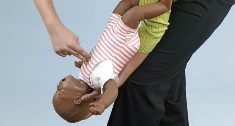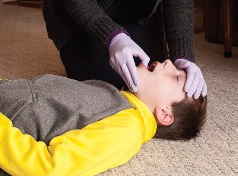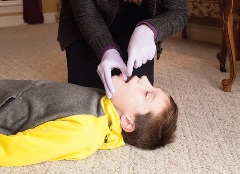Lecture 6
4. Caring for an infant who is choking
When an infant is choking, give a combination of 5 back blows followed by 5 chest thrusts (instead of abdominal thrusts). You can sit, kneel or stand to give first aid care to a choking infant, as long as you are able to support the infant on your thigh with the infant’s head lower than his or her chest. If the infant is large or your hands are small, you may find it easiest to sit or kneel.
Back blows
First, get the infant into position for back blows. Place your forearm along the infant’s back, cradling the back of the infant’s head with your hand. Place your other forearm along the infant’s front, supporting the infant’s jaw with your thumb and fingers. (Be careful not to cover the infant’s mouth with your hand while you are supporting the infant’s jaw.) Turn the infant over so that he or she is face-down along your forearm. Lower your arm onto your thigh so that the infant’s head is lower than his or her chest. Continue to support the infant’s jaw with the thumb and fingers of one hand while you firmly strike the infant between the shoulder blades with the heel of your other hand. Keep your fingers up to avoid hitting the infant’s head or neck. Each back blow should be separate from the others.

Chest thrusts
Next, place one hand along the infant’s back, cradling the back of the infant’s head with your hand. While continuing to support the infant’s jaw with the thumb and fingers of your other hand, support the infant between your forearms and turn the infant over so that he or she is face-up along your forearm. Lower your arm onto your thigh so that the infant’s head is lower than his or her chest. Place the pads of two fingers in the center of the infant’s chest, on the breastbone just below the nipple line. Press down about 1½ inches and then let the chest return to its normal position, keeping your fingers in contact with the breastbone. Each chest thrust should be separate from the others.

Continue sets of 5 back blows and 5 chest thrusts until the infant can cough forcefully, cry or breathe, or the infant becomes unresponsive. After the choking incident is over, even if the infant seems fine, he or she should still be evaluated by a healthcare provider to make sure there is no damage to the airway or other internal injuries.
If the Person Becomes Unresponsive
If a person who is choking becomes unresponsive, carefully lower him or her to the ground and, if you are trained, begin CPR, starting with chest compressions. After each set of chest compressions and before attempting rescue breaths, open the person's mouth and look for the object.

If you see an object in the person's mouth, remove it using your finger. Never put your finger in the person's mouth unless you actually see the object.

If you cannot see the object and you put your finger in the person's mouth, you might accidentally push the object deeper into the person's throat.